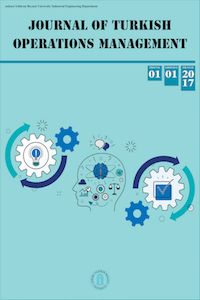MODELLING AND PREDICTING THE GROWTH DYNAMICS OF COVID-19 PANDEMIC: A COMPARATIVE STUDY INCLUDING TURKEY
MODELLING AND PREDICTING THE GROWTH DYNAMICS OF COVID-19 PANDEMIC: A COMPARATIVE STUDY INCLUDING TURKEY
___
- Acar, A.C., Er, A.G., Burduroğlu, H. C., Sülkü, S. N., Aydin Son, Y., Akin, L. and Ünal, S. (2021). Projecting the course of COVID-19 in Turkey: A probabilistic modeling approach. Turkish Journal of Medical Sciences, 51(1):16-27, DOI: https://doi.org/10.3906/sag-2005-378.
- Baldemir, H., Akın, A. and Akın, Ö. (2020). Fuzzy modelling of COVID-19 in Turkey and some countries in the world. Turkish Journal of Mathematics and Computer Science, 12(2):136-150, DOI: https://doi.org/10.47000/tjmcs.751730.
- Carcione, J.M, Santos, J.E, Bagaini C. and Ba J. (2020). A simulation of a COVID-19 epidemic based on a deterministic SEIR model. Frontiers in Public Health, 8:230, DOI: https://doi.org/10.3389/fpubh.2020.00230.
- Chowell, G., Sattenspiel, L., Bansal, S. and Viboud, C. (2016). Mathematical models to characterize early epidemic growth: A review. Physics of Life Reviews, 18:66-97, DOI: https://doi.org/10.1016/j.plrev.2016.07.005.
- Çakır Z. and Savaş, H. (2020). A mathematical modelling for the COVID-19 pandemic in Iran. Ortadoğu Tıp Dergisi, 12(2):206-210, 18:66-97, DOI: https://doi.org/10.21601/ortadogutipdergisi.715612.
- Duhon, J., Bragazzi, N. and Kong, J.D. (2021). The impact of non-pharmaceutical interventions, demographic, social, and climatic factors on the initial growth rate of COVID-19: A cross-country study. Science of the Total Environment, 760:144325, 18:66-97, DOI: https://doi.org/10.1016/j.scitotenv.2020.144325.
- Eroğlu, Y. (2020). “Forecasting models for COVID-19 cases of Turkey using artificial neural networks and deep learning. Endüstri Mühendisliği, 31(3):353-372, 18:66-97, DOI: https://doi.org/10.46465/endustrimuhendisligi.771646.
- Hamer, W.H. (1906). The Milroy lectures on epidemic diseases in England: The evidence of variability and of persistency of type. The Lancet, 167(4305):569-574, , 18:66-97, DOI: https://doi.org/10.1016/S0140-6736(01)80264-6.
- Li, M., Zhang, Z., Cao, W., Liu, Y., Du, B., Chen, C., Liu, Q., Uddin, M.N., Jiang, S., Chen, C., Zhang, Y. and Wang, X., (2021). Identifying novel factors associated with COVID-19 transmission and fatality using the machine learning approach. Science of the Total Environment, 764:142810, 18:66-97, DOI: https://doi.org/10.1016/j.scitotenv.2020.142810.
- Liang, K., (2020). Mathematical model of infection kinetics and its analysis for COVID-19, SARS and MERS. Infection, Genetics and Evolution: Journal of Molecular Epidemiology and Evolutionary Genetics of Infectious Diseases, 82:104306, DOI: https://doi.org/10.1016/j.meegid.2020.104306.
- Liu, Z., Magal, P., Seydi, O. and Webb, G., (2020). A COVID-19 epidemic model with latency period. Infectious Disease Modelling, 5:323-337, DOI: https://doi.org/10.1016/j.idm.2020.03.003.
- Ma, J., (2020). Estimating epidemic exponential growth rate and basic reproduction number. Infectious Disease Modelling, 5:129-141, DOI: https://doi.org/10.1016/j.idm.2019.12.009.
- Nikolopoulos, K., Punia, S., Schäfers, A., Tsinopoulos, C. and Vasilakis, C. (2021). Forecasting and planning during a pandemic: COVID-19 growth rates, supply chain disruptions, and governmental decisions. European Journal of Operational Research, 290(1):99-115, DOI: https://doi.org/10.1016/j.ejor.2020.08.001.
- Önder, H. (2020). Short-term forecasts of the COVID-19 epidemic in Turkey: March 16–28, 2020. Black Sea Journal of Health Science, 3(2):27-30, Available at: https://dergipark.org.tr/tr/pub/bshealthscience/issue/51721/710.
- Pirouz, B., Shaffiee Haghshenas, S., Shaffiee Haghshenas, S. and Piro, P. (2020). Investigating a serious challenge in the sustainable development process: Analysis of confirmed cases of COVID-19 (new type of coronavirus) through a binary classification using artificial intelligence and regression analysis. Sustainability, 12(6):2427, DOI: https://doi.org/10.3390/su12062427.
- Rath, S., Tripathy, A. and Tripathy, A.R. (2020). Prediction of new active cases of coronavirus disease, (COVID-19) pandemic using multiple linear regression model. Diabetes and Metabolic Syndrome Clinical Research and Reviews, 14(5):1467-1474, DOI: https://doi.org/10.1016/j.dsx.2020.07.045.
- Ross, R. (1911). The Prevention of Malaria. London: John Murray. Available at: https://archive.org/details/pr00eventionofmalarossrich. Sarkar, K., Khajanchi, S. and Nieto, J.J., (2020). Modeling and forecasting the covid-19 pandemic in India. Chaos, Solitons and Fractals, 139:110049, DOI: https://doi.org/10.1016/j.chaos.2020.110049.
- Sharma, V.K. and Nigam, U., (2020). Modeling and forecasting of COVID-19 growth curve in India. Transactions of the Indian National Academy of Engineering, 5:697-710, DOI: https://doi.org/10.1007/s41403-020-00165-z.
- Sun, J., Chen, X., Zhang, Z., Lai, S., Zhao, B., Liu, H., Wang, S., Huan, W., Zhao, R., Ng, M.T.A. and Zheng, Y. (2020). Forecasting the long-term trend of COVID-19 epidemic using a dynamic model”, Scientific Reports, 10:21122, DOI: https://doi.org/10.1038/s41598-020-78084-w.
- Tuli, S., Tuli, S., Tuli, R. and Gill, S. S. (2020). Predicting the growth and trend of COVID-19 pandemic using machine learning and cloud computing. Internet of Things, 11:100222, DOI: https://doi.org/10.1016/j.iot.2020.100222.
- Valvo, P. 2020. A Bimodal Lognormal Distribution Model for the Prediction of COVID-19 Deaths. Applied Sciences, 10:8500, DOI: https://doi.org/10.3390/app10238500.
- Velasquez, R.M.A. and Lara, J.V.M. (2020). Forecast and evaluation of COVID -19 spreading in USA with reduced-space gaussian process regression. Chaos, Solitons and Fractals, 136:109924, DOI: https://doi.org/10.1016/j.chaos.2020.109924.
- Wu, K., Darcet, D., Wang, Q. and Sornette, D., (2020). Generalized logistic growth modeling of the COVID-19 outbreak: comparing the dynamics in the 29 provinces in China and in the rest of the world. Nonlinear Dynamics, 101(3):1561-1581, DOI: https://doi.org/10.1007/s11071-020-05862-6.
- ISSN: 2630-6433
- Başlangıç: 2017
- Yayıncı: Ankara Yıldırım Beyazıt Üniversitesi
ORDER PICKER ROUTING PROBLEM IN A SINGLE BLOCK WAREHOUSE
Arif Çağdaş AYDINOĞLU, Süleyman ŞİŞMAN, İrem ERGÜL
Novel last mile delivery models in terms of sustainable urban logistics
Şaban Fatih YILMAZ, Nadide AKTAŞ, Neslihan DEMİREL
Performance Measurement in Cargo Distribution Center A Case Study
Web Sitesi Tasarım Aşamasındaki Kriterlerin Önem Derecelerinin Bulanık Fucom ile Belirlenmesi
Sultan Handenur ATÇI, Kumru ATALAY
Bir imalat firmasında en iyi ürün kalitesi için lazer ile kesim parametrelerinin en iyilenmesi
Mustafa YURDAKUL, Taha TÜKEL, Yusuf Tansel İÇ, İbrahim ÜLKE, Arif BALCI, Serkan GÜNEŞ
Comparison of Covid-19 Vaccines Under Different Coverage Levels and Delivery Periods
Dağıtık üretim içeren dağıtım şebekesi genişleme problemi için yeni bir matematiksel model
Ayşenur YURTSEVER, Berna DENGİZ, Burçin ÇAKIR, İsmail KARAOĞLAN
Quality function deployment implementation on service sector
